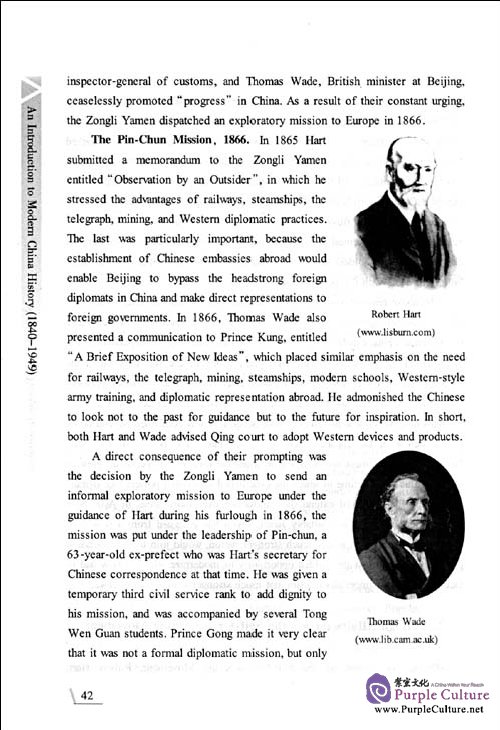The book has been issued owes the generous assistance and wise advice ofsome people. "[he sponsors came from Jinan University. Qiu Yijian helped shapethe outline of the book. Zhang Tingmao reviewed the book and provided thoroughrevise both in history area and language on later drafts. Thanks also should giveto Xu Yixiong, Huang Shengying, who helped to make the professional design ofthe book.
The support of my family is my greatest motivation. My mother, father,sisters, and my son have always been interested in my work. Without theirunderstanding and support, I could do nothing in my research.
Introduction
Part Ⅰ The Opium Wars and the Characteristics Changing of China Society
1. The Situation of China before the First Opium War
2. The British Opium Smuggling and the Anti-opium Campaign in china
3. The First Opium War
4. The Consequences of the First Opium War to China Society
5. The Second Opium War
6. The Appearance of the New Ideological
Part Ⅱ Self-Strengthening in the Age of Accelerated Foreign
Imperialism
1. The Domestic Situation of China during the Opium Wars
2. The Self-Strengthening Movement
3. Foreign Affairs during the Self-Strengthening Movement
4. The Sino-French War
5. The First Sino-Japanese War
Part Ⅲ Reform under the Menace of Partition
1. The Menace of Partition
2. The Reform Movement and Hundred Days Reform
3. The Boxer Movement
4. Late-Qing Reforms and the Constitutional Movement
Part Ⅳ Revolution and Republic
1. The Situation of China at the Turn of the 20th Century
2. The Rise of the Bourgeoisie Revolutionary Groups
3. The Further Unstable of the Qing Dynasty and the Xinhai Revolution
4. The Founding of the Republic of China
5. The Protection of the Republic (1912- 1920)
Part Ⅴ Ideological Awakening and the National Revolution
1. The Intellectual Revolution
2. The May Fourth Movement, 1919
3. The Expansion of the New Culture Movement and the Founding of the Chinese Communist Party
4. The Nationalist Party Reorganization and the First United Front
5. The Rise of the Nationalist Movement
Part Ⅵ The Struggling of the Nanjing Government from 1927 to 1937
1. The Politic Power Struggle
2. The Struggle for National Reconstruction
3. The Chinese Communist Party's Struggle
Part Ⅶ The War of Resistance against Japan ( 1937 - 1945 )
1. The Japanese Invasion Activities to China before 1937
2. Japanese Full-Scale Attack to China
3. Chinese Resistance Strategy before the Entrance of Western Allies
4. Foreign Supports to China
5. Relationship between the Nationalists and Communists during the War
Part Ⅷ The Civil War in China ( 1945 - 1949) and the Establishment of the People's Republic of China
1. The Situation of China after the End of the War of Resistance against Japanese
2. Chongqing Negotiation
3. The Full-scale Civil War
4. The Establishment of the People's Republic of China
References Books
Acknowledgments

All these prevented any great growth of capital invested in industry andtrade. And not agency promoted the social classes changing.
When it came to the First Opium War, the Chinese political system, socialstructure, economic institutions and intellectual atmosphere remainedsubstantially what they had been during the previous 2,000 years. The polity wasa dynasty ruled by an imperial family, the economic was basically agrarian andself-sufficient, and the society centered on the gentry, and the dominant ideologywas Confucianism.
A common view of 19th century China is that it was an era in which Qingcontrol weakened and prosperity diminished. Indeed, China suffered massivesocial strife, economic stagnation, and explosive population growth which placedan increasing strain on the food supply. The basic reason is that Qing power was,over the course of the century, faced with internal problems and natural disasterswhich were simply too much for the antiquated Chinese government to deal with.The land was concentrated in the hands of the royal members, the importantofficers and landlords. In a word, the feudalism system of China was coming tothe end.
The Contacts between China and the West: Before the First Opium War,China did have intermittent contacts with the West from Han dynasty to the Age ofthe Discovery. Those contacts included the importation of Chinese silk to Rome,and the arrival of Roman jugglers and merchants in A. D. 120 and A. D. 166.During the Tang dynasty (618-907), Nestorian Christianity and Mohammedanismentered China, and the Arabs were active in Chinese foreign trade. The Yuandynasty witnessed the coming of the Venetian merchants; the famous one isMarco Polo. The Ming dynasty saw the great maritime expeditious conducted byZheng He. But the direct contacts of China and the West were driven by Europe.By the Age of Discovery, Portuguese oceanic expeditions carried explorers andempire-builders to Asia, followed by traders and missionaries. But it was notuntil the Industrial Revolution that the West generated power sufficient to make avigorous and sustained effort to reach China.